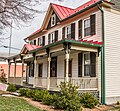Marshall Historic District | |
 Marshall, Virginia Historic District | |
| Location | Including parts of Anderson R., Emerald Ln., Frost St., Main St., Rosstown Rd. Wild Aster Ct. and Winchester Rd., Marshall, Virginia |
|---|---|
| Coordinates | 38°51′59″N77°51′17″W / 38.86639°N 77.85472°W |
| Area | 99 acres (40 ha) |
| Built | 1771 |
| Built by | Cain, H.L.; Fleming, Irvin, et al. |
| Architectural style | Federal, Gothic Revival, et al. |
| NRHP reference No. | 07000191 [1] |
| VLR No. | 030-5156 |
| Significant dates | |
| Added to NRHP | March 19, 2007 |
| Designated VLR | December 6, 2006 [2] |
Marshall Historic District is a national historic district located at Marshall, Fauquier County, Virginia. It encompasses 314 contributing buildings and 3 contributing sites in the rural village of Marshall. The district represents a collection of historic buildings with a wide range of building types and architectural styles that date from the end of the 18th century to the mid-20th century. Notable buildings include the Fauquier Heritage and Preservation Foundation building (c. 1771), hosteller's house for Rector's Ordinary (c. 1800), a store and Confederate post office (c. 1805), the Elgin House (c. 1820, 1892), former Marshall Pharmacy (c. 1830), the Foley Building (c. 1830), the Gothic Revival style Trinity Episcopal Church (1849), Salem Baptist Church (1929), Marshall United Methodist Church (1899), and the Marshall Ford Company (1916), reputed to be the oldest building built as a Ford dealership in the United States that is still functioning as such. [3]
It was listed on the National Register of Historic Places in 2007. [1]
















